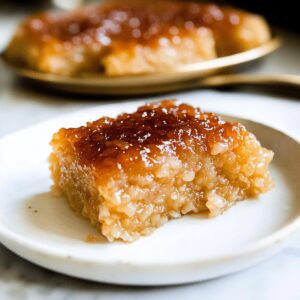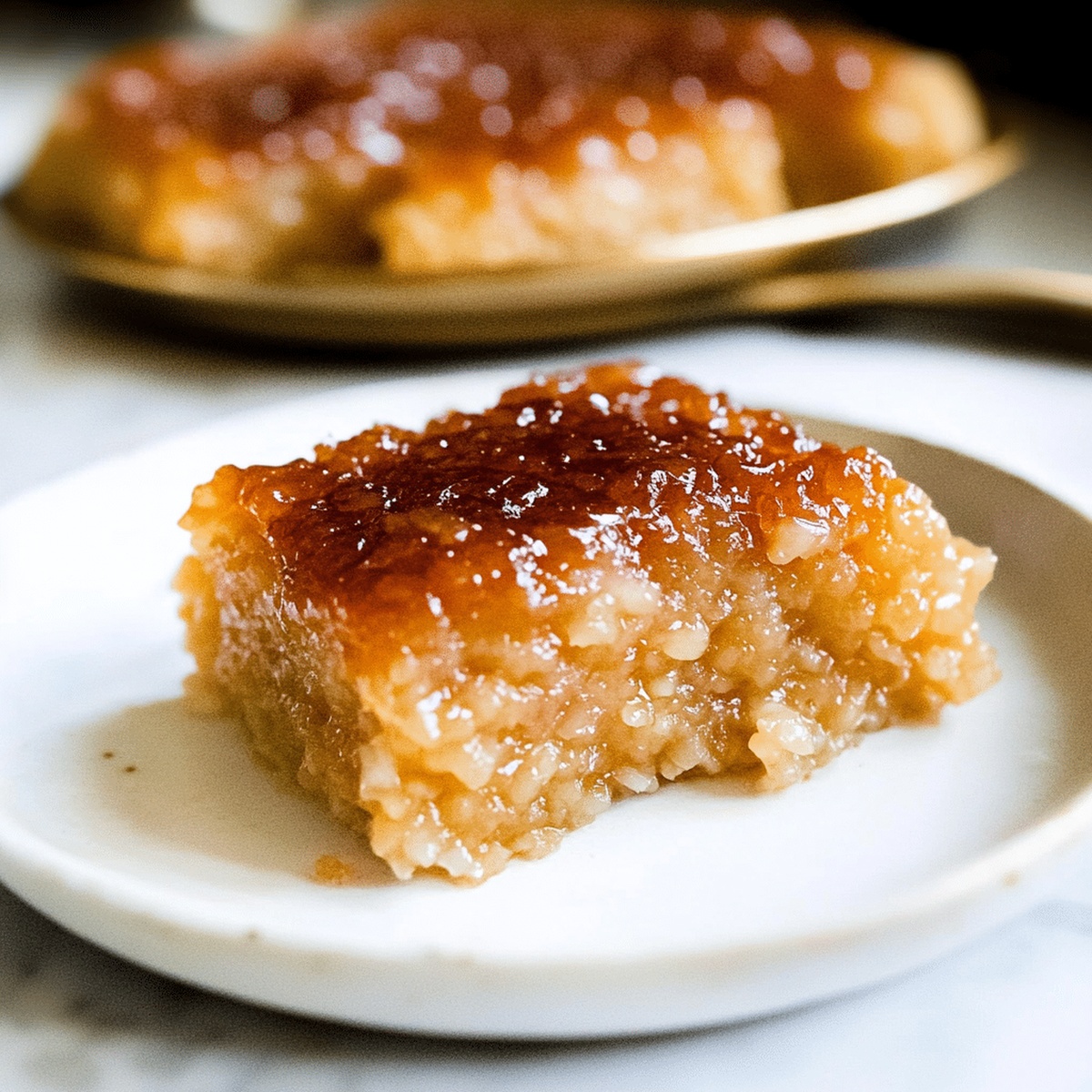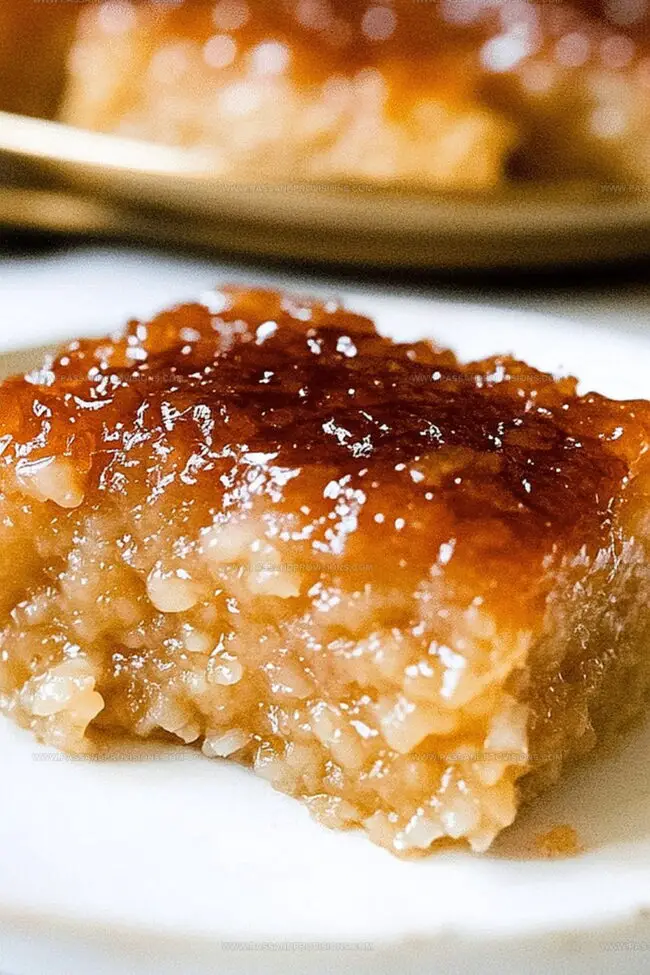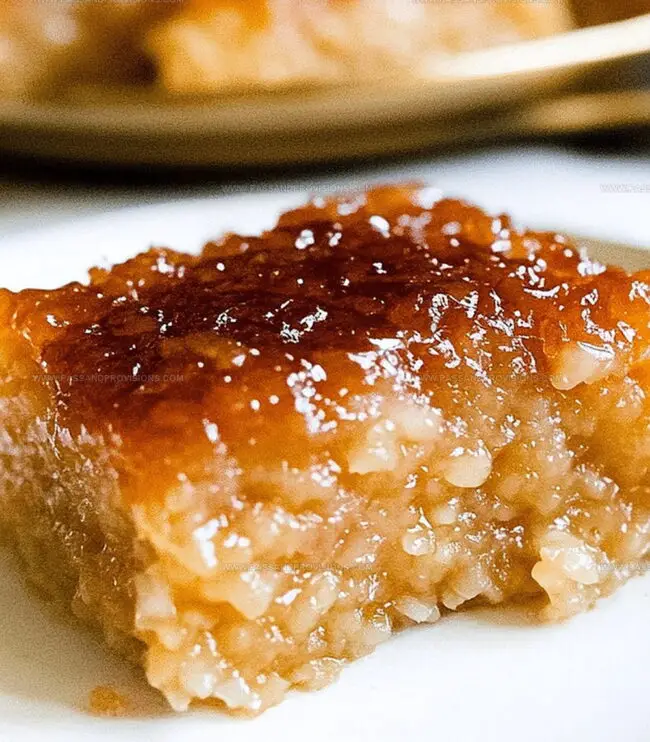Biko Recipe Sweet and Sticky Filipino Delight
Sweet sticky biko captures the heart of Filipino dessert traditions with its rich coconut allure.
Families across the Philippines cherish this delectable rice cake passed through generations.
Glutinous rice transforms into a heavenly treat when combined with caramelized coconut milk.
Creamy and indulgent, each bite tells a story of culinary heritage.
Layers of flavor dance between soft rice and golden brown topping.
Comfort comes in simple ingredients that speak volumes about cultural connections.
You’ll find this dessert irresistibly easy to create and share with those you love.
Prepare to experience a delightful journey of taste that connects you directly to Filipino kitchens.
Why Biko Stands the Test of Time
Everything You’ll Need for Filipino Biko
Main Rice Ingredient:Sweetening Ingredients:Topping Ingredients:How to Make Biko from Scratch
Step 1: Prepare Rice Base
Thoroughly rinse glutinous rice under cool running water until liquid becomes transparent. Transfer rice to rice cooker or large pot. Add water and cook until rice reaches soft, tender consistency. Set cooked rice aside.
Step 2: Create Caramel Coating
In a wide saucepan, combine brown sugar and coconut milk. Heat mixture over medium flame, stirring constantly to prevent burning. Continue cooking until:Step 3: Blend Rice and Caramel
Gently fold cooked glutinous rice into caramel sauce. Use wooden spoon to ensure every rice grain gets evenly coated. Mix thoroughly until rice absorbs caramel and turns golden brown.
Step 4: Transfer and Shape
Pour rice mixture into greased rectangular baking pan. Use spatula to spread evenly and create smooth surface. Press down gently to compact rice.
Step 5: Final Caramel Touch
Drizzle additional coconut caramel sauce over top of rice. Allow biko to cool and set at room temperature for approximately 30 minutes.
Step 6: Slice and Serve
Cut biko into diamond or square shapes. Serve at room temperature as delightful Filipino dessert. Optional: Garnish with extra caramel sauce or coconut shavings.
Tips That Help Biko Turn Out Perfectly
How to Keep Biko Soft and Sticky for Days
What to Serve with Biko for a Sweet Spread
Biko Variations You Should Try
FAQs for Biko
Glutinous rice, also known as sticky rice or sweet rice, is a short-grain rice with high starch content. You can find it in Asian grocery stores, international food sections of supermarkets, or online retailers like Amazon.
No, regular rice won’t work for biko. Glutinous rice has a unique sticky texture that’s essential for creating the traditional dessert’s characteristic consistency and mouthfeel.
While delicious, biko is a sweet treat high in carbohydrates and sugar. It’s best enjoyed in moderation as an occasional dessert rather than a daily food item.
Biko is a Filipino rice cake uniquely prepared with coconut milk and brown sugar, giving it a distinct caramelized flavor and sticky texture that sets it apart from other rice-based desserts.
Print
Easy Biko Recipe
- Total Time: 40 minutes
- Yield: 8 1x
Description
Sweet Filipino coconut rice cake Biko brings comfort and tradition to your dessert table. Sticky rice, coconut milk, and brown sugar blend into a delightful treat that connects you with Philippine culinary heritage.
Ingredients
Main Ingredients:
- 2 cups glutinous rice (malagkit)
- 1 can (13.5 ounces/383 grams) coconut milk
- 1 cup brown sugar
- 2 ¼ cups water
Flavoring and Seasoning:
- ½ teaspoon salt
Latik Topping (Optional):
- ½ cup coconut cream
- 2 tablespoons brown sugar
Instructions
- Thoroughly rinse glutinous rice under cold running water, ensuring water becomes translucent, indicating removal of excess starch.
- Transfer rinsed rice to rice cooker or heavy-bottomed pot, adding precise water quantity to achieve perfectly tender grains.
- Cook rice until fully soft and fluffy, utilizing rice cooker’s automated function or carefully monitoring stovetop preparation.
- While rice completes cooking, prepare rich coconut caramel mixture in separate saucepan by combining brown sugar and coconut milk.
- Heat coconut-sugar blend over medium flame, continuously stirring to prevent scorching and achieve smooth, glossy consistency.
- Once caramel transforms into deep amber color with rich, fragrant aroma, gently fold cooked glutinous rice into mixture.
- Stir rice thoroughly, ensuring each grain becomes evenly coated with luxurious coconut caramel sauce.
- Transfer caramelized rice mixture into greased baking pan, spreading contents uniformly for consistent texture.
- Allow biko to settle and absorb remaining caramel sauce, creating dense, sticky traditional Filipino dessert.
- Optional: Garnish surface with additional latik (caramelized coconut cream solids) for enhanced visual appeal and complementary flavor profile.
- Let biko cool completely before slicing into traditional square or diamond-shaped servings.
Notes
- Rinse thoroughly to remove excess starch, ensuring each grain remains distinct and fluffy when cooked.
- Choose high-quality glutinous rice for the most authentic sticky texture and rich flavor profile.
- Experiment with coconut varieties like young or mature coconut milk to create subtle depth in your biko’s sweetness.
- For a lighter version, substitute some brown sugar with coconut sugar or reduce overall sugar content to suit health-conscious preferences.
- Prep Time: 10 minutes
- Cook Time: 30 minutes
- Category: Desserts, Snacks
- Method: Boiling
- Cuisine: Filipino
Nutrition
- Serving Size: 8
- Calories: 250
- Sugar: 20g
- Sodium: 150mg
- Fat: 9g
- Saturated Fat: 8g
- Unsaturated Fat: 1g
- Trans Fat: 0g
- Carbohydrates: 37g
- Fiber: 1g
- Protein: 3g
- Cholesterol: 0mg




Jamie Granger
Recipe Developer & Food Writer
Expertise
Education
Culinary Institute of America
Jamie Granger turns ingredients into memories. With her recipes, she brings a fusion-forward flair to every creation.
Her dishes reflect the places she’s explored, the chefs she’s learned from, and the deep connection she has to food as a form of expression.
At Pass and Provision, Jamie develops recipes that balance flavor, health, and beauty, meals that don’t just satisfy your appetite but speak to your curiosity.